You pitch to decision-makers.

Everyone tries to start their own business at least once… but very few people you talk to are currently running their own business.
Those who tried and failed often have the same story. They went into business fearing the worst, tried anyway, and they self-sabotaged their way to making their fears a reality.
Failing as a freelancer is often a self-fulfilling prophecy. A foregone conclusion.
It has little to do with market conditions, the economy, or an impending recession.
It’s blindly walking into the face of the world's indifference, seeing that there’s no safety net to save them, and realizing that they are better off with the stability of employment.
Fail to plan, plan to fail.
Those who make it past the first year of self-employment have a lot in common with doomsday preppers: they live to see another day.
Days of survival become weeks. Weeks become months. Eventually, you realize that the bank balance is going up every month.
You lived to fight another battle.
$50K - $100K Per Year: Survival of the Prepared (read more)
$100K - $250K Per Year: Leveling Up and Turning a Profit (read more)
$250K - $500K Per Year: Acting Like a Real Company (read more)
$500K - $1Mil Per Year: Double or Nothing (read more)
$1Mil - $2Mil+ Per Year: Reaping the Benefits (read more)
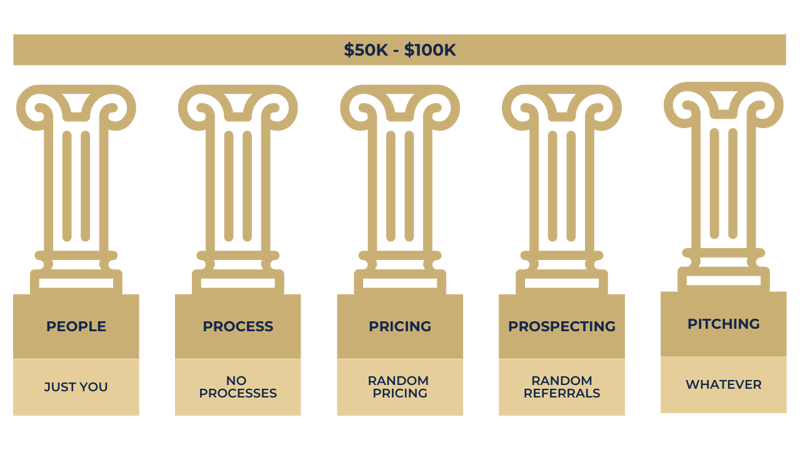
Those who survive through the 3-6-12 months? They spent time building their safety net or took their safety net with them along the way.
Aggressive savings. Take their old job with them as a contractor. Networking their way into a client roster of spare parts.
The next $50k is equally hard.
Thinking beyond that is a luxury.
It’s just you, yourself, and your spare bedroom at this point.
You’re a one (wo)man show. Employee #1.
Chief operations officer (COO). Chief financial officer (CFO). Chief revenue officer (CRO). Head of HR.
Jack of all trades, master of your craft.
Every new project faces the same dilemma.
The CRO in you will take any money you can get.
The CFO in you knows that’s a bad idea.
The COO in you prepares for an all-nighter of reinventing the wheel.
You’re paying yourself about $12 an hour. The HR head in you is concerned you’re violating local labor laws.
Do you incorporate or form an LLC?
Do you hire contractors or employees?
How do you pay taxes?
Can I write this off?
What about health insurance?
But even with the distractions and nagging feelings of doubt, you know this has the potential to be WAY better than a job.
If only you can make it to six figures, then everything will change!
Then when you hit six figures, you realize the journey has just started. But the destination becomes clearer.
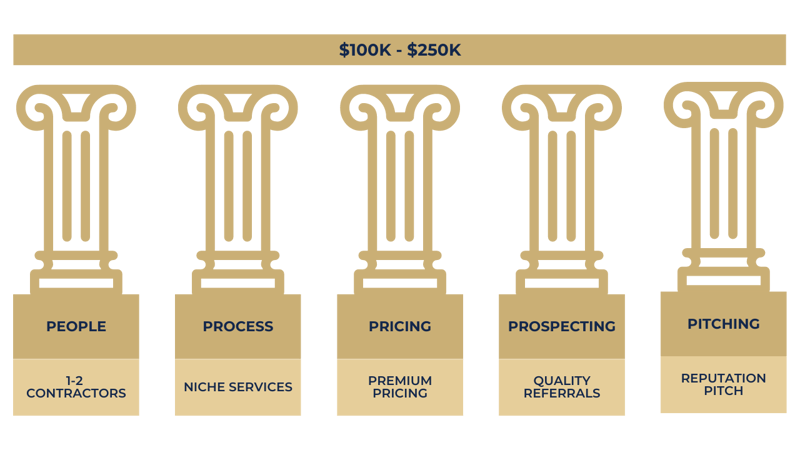
You know the one.
The check that pays off your debt.
Or adds an extra zero to your bank balance you never knew was possible.
Or gives you your first “round figure” month.
Suddenly, your previous struggles look easy by comparison.
You’re no longer invested in surviving on basic needs. You wonder what it’s like to thrive.
You’ve experienced life-changing freedom. The sweet hints of success.
How can you keep these wins coming over the long run?
Where should you spend your time?
Should you spend your hard-earned money now or reinvest in the business?
Should you take a vacation or hire an employee?
Can you even take a vacation without working the whole time?
Oh no! Do you need to hire employees?
Or read business books? Or Niche down?
Or hire a coach? Or cold call people?
Maybe you can just buy everything on Appsumo and build your business around that?
You should absolutely hire someone off Upwork to get the easy stuff done.
You should probably choose a niche to focus on, so you’re not hiring 50 people off Upwork to do custom work for each client.
Speaking of legacy clients, isn’t it about time to let some of them go?
You should only take on the best referrals that come your way.
Farm out the others to some newbie going through the same challenges you did a year ago.
Your reputation is growing by now, so the best referrals come already sold.
Life is good! Business is easy! You’re a genius!
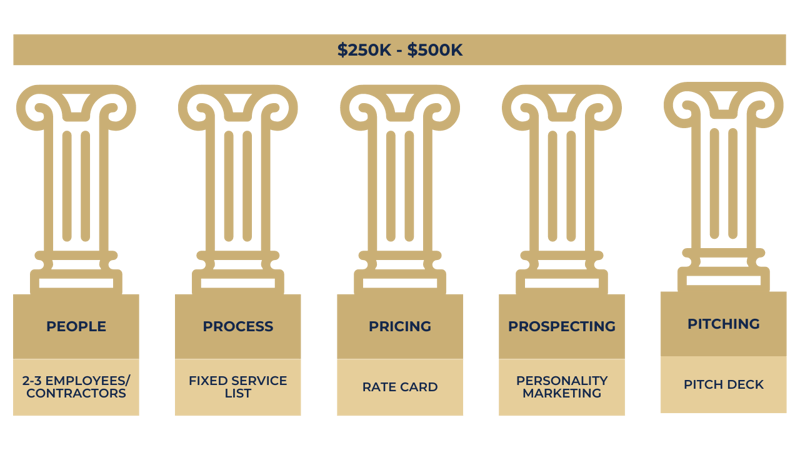
You feel the need to start running your business like a “real” business and wonder what’s involved there.
What does a “real” business do, anyway?
Is being a “real” business simply emulating a bigger business?
Bigger businesses have it so easy!
Their leaders lead. Their doers do. Their shareholders profit.
Or is it?
Larger businesses have similar challenges to yours, just at a bigger scale.
More risk. More potential reward.
The other thing they have that you are missing? Dedicated resources to solving specific problems.
Big companies know these pillars by another name.
Operations. Finance. Marketing. Sales.
You’ve played every one of these roles for your business. It’s what got you here.
It’s time to stop thinking in terms of survival.
It’s time to think in terms of abundance.
It’s time to take the patchwork company you built and start leveling up every function - not necessarily with full-time employees.
You can’t afford to fill all these roles yet.
Fractional resources at first. Entire departments when revenue allows.
Your company needs to hire better.
You need to document your processes.
You need to take on profitable clients.
You need to build your prospecting flywheel.
You need to win sales, not just accept referrals.
You start to see how the puzzle pieces fit, and you just need to put them together.
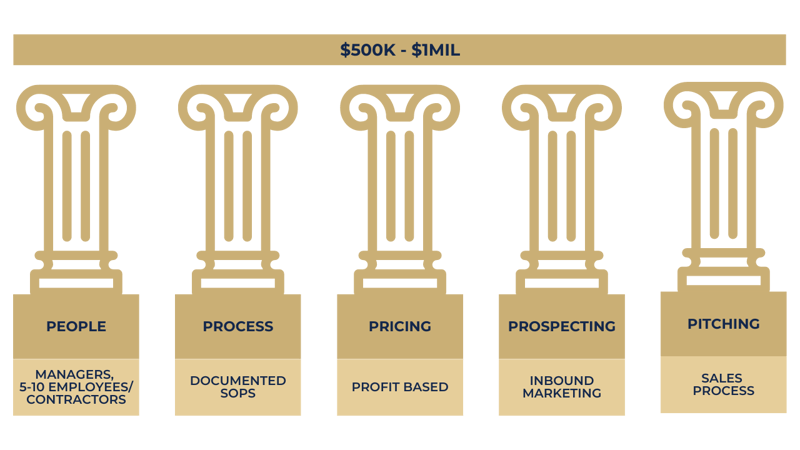
The defining moment of the next level of your business is how you define yourself moving forward.
You’re no longer an expert consultant.
What got you to this point is what will prevent you from leveling up further.
Trust me. I treaded water here for four years before finally admitting I needed help.
At this stage, it’s clear you are awesome at what you do.
The strengths of the founder become the weakness of the company.
And until you give up on the notion of perfection, you will constantly be pushing yourself against a ceiling.
This is true for every phase of your business, of course.
Achieving perfection in just one pillar leaves you unbalanced.
You can charm your way through this imbalance for years.
But when you try to ascend to the next level? You get knocked down a few pegs.
It’s time to give up your babies and do what’s best for the company.
It’s time to oversee the construction of your dream business, not hammer every nail.
It’s time to become a CEO.
CEOs are responsible for the direction of companies, but you’ll never see them doing the work.
They are insulated. They protect themselves through structure.
They care about broad strokes.
The top and bottom lines.
They hire great people to do the rest.
But isn’t that expensive?
Most business ideas don’t make it this far, so you’re already winning.
It’s like doubling down on a blackjack table when the dealer is showing a 6 and you have an 11 (63.6% chance of winning).
You’re not always going to win, but it’s the best odds you’ll see.
This is when you begin to hire your “dream team” that will lead you to seven figures and beyond.
It’s not always profitable. It’s frequently ugly.
But think of it as a right of passage.
An initiation into the seven-figure club.
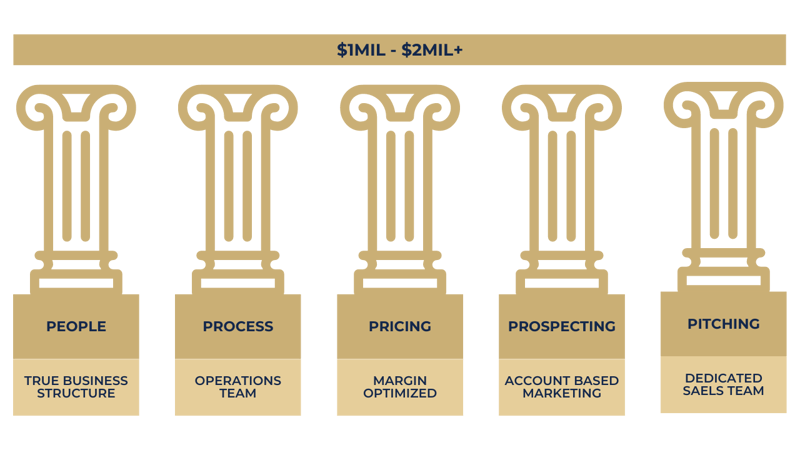
Once a company reaches its first seven figures, momentum will push them to another million in revenue within a few years.
With a solid infrastructure in place, the system starts to generate the wins, not just the entrepreneur who started.
Sales are made by a dedicated sales team.
Leads are generated from targeted prospects using techniques like account-based marketing, cold outreach, and targeted forms of prospecting.
Your pricing is never in question, and every proposal is optimized for profit. You generate a margin on every piece of work you deliver.
And delivery has never been easier with a dedicated team in place to make sure everything is done consistently and effectively.
How’s that possible?
Because you have structured your business to have the right people for the job and developed a team that exists to your company’s vision.
Sure, maybe you don’t go above and beyond the call of duty anymore… but you’re not in the superhero business, are you?
It’s the main reason why multi-seven-figure business owners usually have a smile on their face… and the struggling five and six-figure entrepreneurs can hardly muster a smile. Myself included, from time to time.
The dollar amounts don’t have to be exact, but the pillars need to be in place if you want to raise the ceiling of your business.
This often involves being uncomfortable and leveling up as a business owner.
You’ll generally have to compromise and declare aspects of your business “good enough for now” so you can focus on other pillars that need work.
Some pillars are easy to fix on paper - Pricing for example.
But it’s hard to raise your price when you have no business in the pipeline.
It’s hard to generate new business when you are overworked.
It’s hard to hire people or build a process when you don’t have money coming in.
The biggest mistake we all make is focusing too much on a single pillar, a pillar that is only functional once the other four foundational elements are in place.
Leveling up is a part of business, but it’s also important to keep your pillars level along the way.